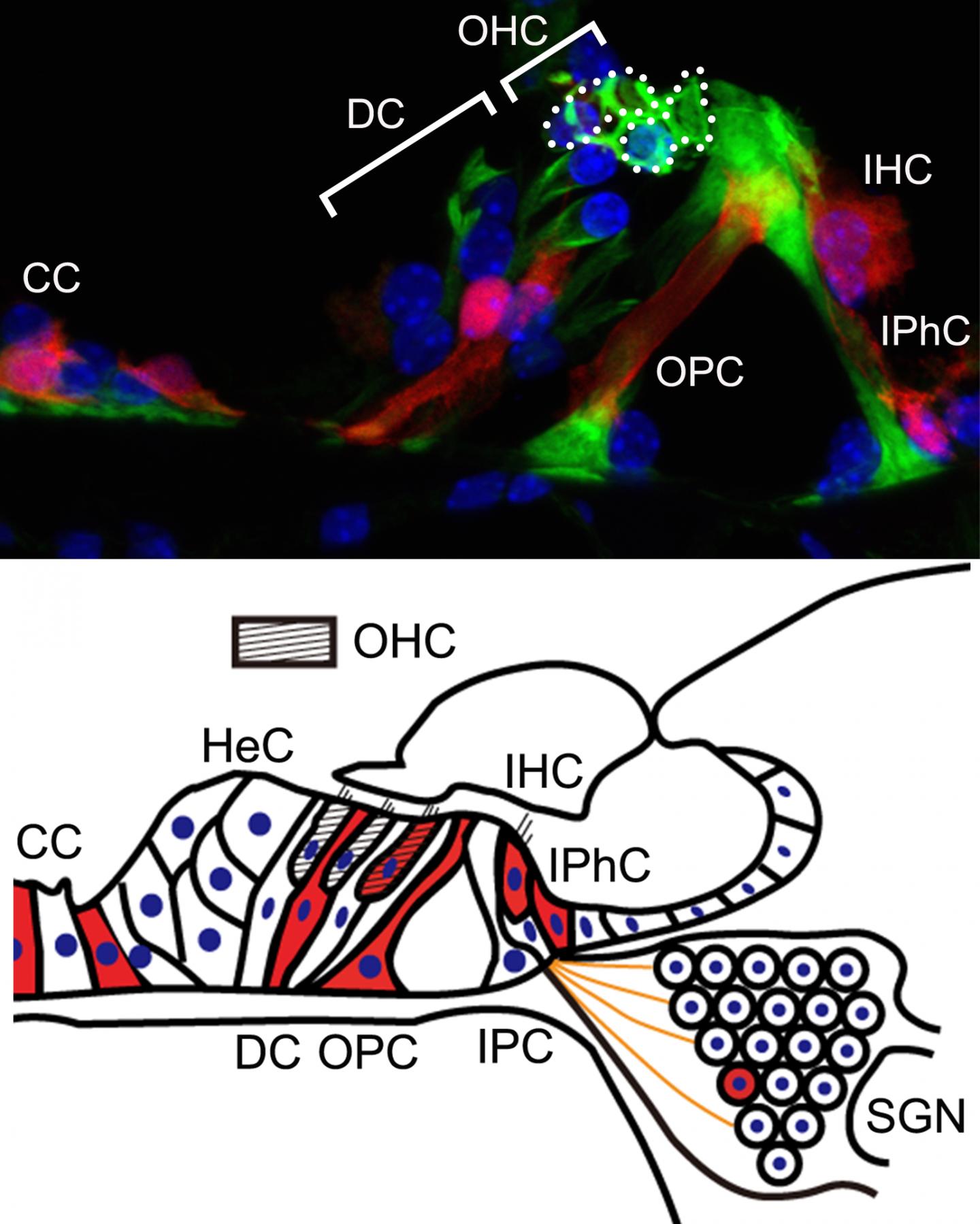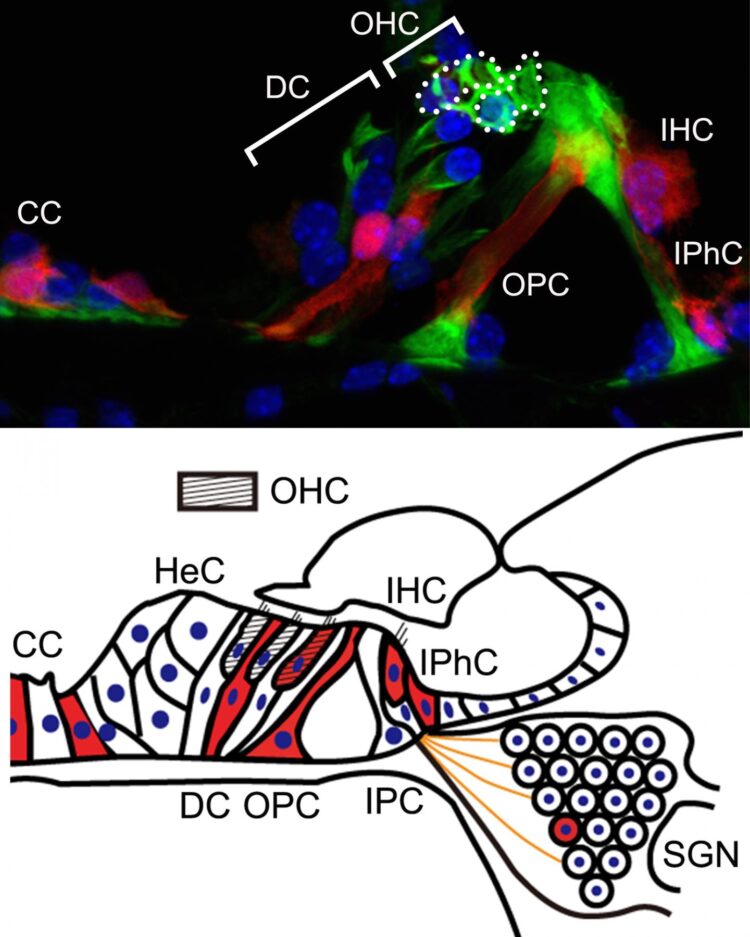-Breakthrough discovery will pave the way for the development of the world’s first pharmacological interventions against hearing loss-

Credit: Takehiko Ueyama
Professor UEYAMA Takehiko (Biosignal Research Center, Kobe University) and the inner ear research group (Kyoto Prefectural University of Medicine) have identified the cell types in the inner ear cochlea (*1) responsible for the production of superoxide (Nox3*2-expressing cells). They achieved this by using genetically modified mice that they developed. The researchers discovered that these superoxide-producing cells increase in number in response to aging, noise damage, and ototoxic drugs, thus causing age-related, noise-induced and drug-induced hearing loss. In addition, they were able to suppress the onset of these three types of acquired hearing loss in genetically modified mice with no Nox3 expression (Nox3 knockout).
These results are expected to contribute towards the development of the world’s first drug-based treatment for hearing loss. Future treatments could involve removing reactive oxygen species from the cochlea, suppressing their production, or the development of Nox3 inhibitors.
These research results were published in the official journal of the Society for Neuroscience ‘Journal of Neuroscience‘ on April 12, 2021.
Main Points
- It is known that NADPH oxidase 3 (Nox3) is only expressed in the inner ear; however, it was not known which cells are involved in this, nor when or how Nox3 is expressed. In a world first, this research team has revealed the cells in the inner ear responsible for Nox3 expression and its mode of expression by using the genetically modified mice that they developed.
- It was discovered that Nox3-expressing cells increase gradually with age, and suddenly in response to noise damage and ototoxic drugs.
- The researchers were able to control the onset of age-related, noise-induced, and drug-induced hearing loss in Nox3 knockout mice, in which Nox3 is unable to be expressed. In particular, they were able to significantly suppress the onset of age-related and drug-induced hearing loss.
- If a drug to suppress the expression and/or activity of Nox3 could be developed, this would aid the development of effective treatment methods for the many patients with the abovementioned major types of acquired hearing loss.
Research Background
Sensorineural hearing loss (*3) is the most common type of sensorineural impairment. Around 5% of the global population have some kind of hearing impairment; however, there are still no established treatments, particularly pharmacological interventions, for these conditions.
It is said that hearing loss related to aging occurs in between 25%-40% of adults over 65, and there are around 10 million people with this condition in Japan alone. Noise-induced hearing loss is still one of the most common aftereffects experienced by former soldiers; however, they are not the only people who develop this impairment. According to a statement by the World Health Organization (WHO) in 2019, around 50% of young people aged 12-35 (1.1 billion people) are at risk of suffering from noise-induced hearing loss in the future due to overexposure to high noise levels resulting from the popularization of portable media players, such as smartphones. There is also drug-induced hearing loss, which can occur as a side effect of taking medications such as antibiotics, anticancer drugs, diuretics, painkillers and anti-inflammatory drugs. Consequently, the number of people with hearing loss is increasing in modern society, and developing treatments for this has become a pressing issue.
Superoxide, a kind of reactive oxygen species, produced by NADPH oxidases (Noxs) contribute towards the development of different types of sensorineural hearing loss. Among the seven types of Noxs found in humans, Nox3, which is specifically expressed in the inner ear, has been reported to be the origin of superoxide. However, the cell types in the inner ear cochlea that express Nox3 was not known, and it was not understood when nor how Nox3 is expressed. The mechanism by which it causes hearing loss was also unclear.
Research Methodology and Findings
This research group has created many mouse models using gene manipulation in order to investigate the causes of hearing loss in patients and develop treatments for them. For this experiment, they developed a mouse model (Nox3-Cre;tdTomato), in which red fluorescent light-emitting proteins (tdTomato) would be expressed in the Nox3-expressing cells, and a Nox3 knockout mouse line (Nox3-KO), in which Nox-3 is unable to be expressed. Using these mice, they were able to identify the Nox3-expressing cells in the inner ear cochlea (which is responsible for hearing), in other words the cells responsible for producing superoxide (Figures 1 and 2). Furthermore, they also revealed that Nox3 plays an important role in the onset of all of the following major types of acquired hearing loss (*4): age-related hearing loss, noise-induced hearing loss and drug-induced hearing loss (Figure 3).
First, the researchers used the mice with red fluorescent tdTomato proteins in Nox3-expressing cells, and a fluorescence microscope to track the temporal expression of red fluorescence in the cells of the mice after birth. They discovered increased red fluorescence in the following cells inside the cochlea (which is responsible for hearing): hair cells (*5), various types of supporting cells (that provide anatomical support to hair cells) and spiral ganglion neurons (the first afferent neuron for hearing connected to hair cells) (Figures 1 and 2).
Of the two types of hair cell inside the inner ear; outer hair cells are more vulnerable to various outside stimuli than the inner hair cells. A loss of outer hair cells is a known manifestation in many cases of hearing impairment. The research team investigated this in detail using two different types of genetically modified mice: mice that retained the Nox3-mediated ability to produce superoxide (heterozygous Nox3-Cre/–;tdTomato) and mice with this ability removed (homozygous Nox3-Cre+/+;tdTomato). In the first group of mice, which retained the ability to produce superoxide, the inner hair cells emitted red fluorescence from tdTomato protein (in other words, they expressed Nox3). However, Nox3 was not observed in the outer ear cells, regardless of aging, noise, or cisplatin inducement (cisplatin is a well-known anticancer agent that has hearing loss as a side effect). Using the latter group of mice (that were unable to produce superoxide), the researchers found that the number of cells expressing fluorescent tdTomato protein (in other words, cells that originally had the ability to express Nox3) increased in response to aging, noise, and drug inducement. From these results, they determined that Nox3-expressing (i.e. superoxide producing) outer hair cells are poisoned by superoxide and die (apoptosis). In addition, the researchers revealed that loss of outer hair cells could also result from superoxide produced by surrounding supporting cells expressing Nox3, even if the outer hair cell didn’t express Nox3 itself.
The team used Nox3-KO mice to investigate the effects of Nox3 on age-related, noise-induced and drug-induced hearing loss, and found that it was easier to suppress both the onset and degree of all these types of hearing loss in Nox3-KO mice than in wild-type mice. They also found that they could suppress age-related and drug-induced hearing loss to a greater degree than noise-induced hearing loss.
Additionally, the researchers discovered that cisplatin-induced increases in Nox3-expressing cells and the subsequent onset of drug-induced hearing loss were weaker in older mice. This result corresponds with clinical data showing that cisplatin-induced hearing loss is more frequent in children under 15 years old.
This research identified the cells in the inner ear cochlea that express Nox3 (in other words, the origin of superoxide in the cochlea) and discovered that induced Nox3 expression causes outer hair cell apoptosis (loss/death) resulting in hearing loss (aging, noise, and drug related). Consequently, the researchers revealed that inhibiting Nox3’s expression or function could provide a promising approach for preventing the onset of acquired hearing loss.
Further Developments
Hearing loss is the most common sensorineural impairment and is only expected to increase in the future; however, there is a need to develop pharmacological interventions for these conditions. This research has revealed that superoxide produced by Nox3 in the inner ear cochlea causes the apoptosis (loss/death) of outer hair cells, which causes at least the following types of acquired hearing loss: age-related, noise-induced, and drug-induced. The results also show that there is a possibility of preventing the onset of the major types of acquired hearing loss by inhibiting Nox3 expression and function in the cochlea. Fortunately, if such a Nox3 inhibitor were to be developed, its side effects on the rest of the body are likely to be mild because Nox3 has been reported to be specifically expressed in the inner ear.
As for genetic sensorineural hearing loss, progress is being made in developing treatments for each specific disorder separately. However, there are far fewer patients with genetic hearing loss compared to those with acquired hearing loss.
If a pharmacological treatment method were to be developed for the abovementioned three main types of acquired hearing impairment, it would not only be the first drug-based treatment for hearing loss in the world, but could also aid the development of such treatments for genetic hearing loss as well.
The results of this study represent a breakthrough in the development of drugs to treat hearing loss and will be of great benefit to society.
###
Glossary
1. Cochlea and the modiolus: The ear is divided into the outer ear, middle ear and inner ear. The cochlea (which is responsible for hearing), the vestibule and the three semi-circular canals (both responsible for balance perception) are located in the inner ear. Outer hair cells are located in the cochlea, and the otolith is found in the vestibule. The cochlea is shaped like a snail’s shell, and the modiolus is the conical-shaped central axis in the cochlea. In humans, the spiral canal of the cochlea is around 35 mm long and turns approximately 2 ¾ times around this central axis.
2. Nox3: Nox3 is one of seven types of nicotinamide adenine dinucleotide phosphate oxidase (NADPH oxidase: Nox) found in humans. Nox3 is only expressed in the inner ear.
3. Sensorineural hearing loss (hearing loss): This is hearing loss resulting from damage to a particular region, ranging from the hair cells in the inner ear cochlea to the auditory center located in the temporal lobe of the brain. Most cases are caused by damage to the cochlea’s hair cells. On the other hand, hearing loss caused by damage to the pathway that conducts sound from the outer ear to the middle ear (such as damage resulting from middle ear inflammation or tympanic membrane injury) is called conductive hearing loss.
4. Acquired hearing loss: Sensorineural hearing loss is divided into two categories depending on when it first occurs: genetic (congenital) hearing loss and acquired hearing loss. The former is caused by genetic abnormalities, and the latter is caused by outside factors after birth. Examples of acquired hearing loss include age-related, noise-induced and drug-induced hearing loss, in addition to hearing loss caused by other factors, such as injuries or infections.
5. Hair cells: These are the primary receptor cells for hearing and they convert sound waves into electrical signals. Each cell has auditory hairs on its upper surface, which function as sensors- their movement picks up sound waves and transforms these waves into electrical signals. There is one row of inner hair cells and three rows of outer hair cells. Humans have around 4000 inner hair cells and approximately 15,000 to 20,000 outer hair cells; however, these cells cannot be regenerated once they have been damaged.
6. Organ of Corti: Located in the cochlea and composed of inner hair cells, outer hair cells, and various types of supporting cells, the organ of Corti is the receptor organ for hearing and converts sound waves (physical stimuli) into electrical signals. It is named after Alfonso Corti, the Italian physician who discovered it.
Acknowledgements
This research received funding from the following public interest incorporated foundations:
The Hyogo Science and Technology Association, the Uehara Memorial Foundation, the Naito Foundation, the Japan Foundation for Applied Enzymology, and the Terumo Life Science Foundation.
This research was also supported by JSPS KAKENHI grants (JP19K22472, JP21H02672) from the Japan Society for the Promotion of Science.
Journal Information
Title:
“Nox3-derived superoxide in cochleae induces sensorineural hearing loss”
DOI: https:/
Authors:
Hiroaki Mohri, Yuzuru Ninoyu, Hirofumi Sakaguchi, Shigeru Hirano, Naoaki Saito, and Takehiko Ueyama
Journal:
Journal of Neuroscience
Media Contact
Verity Townsend
[email protected]
Related Journal Article
http://dx.





